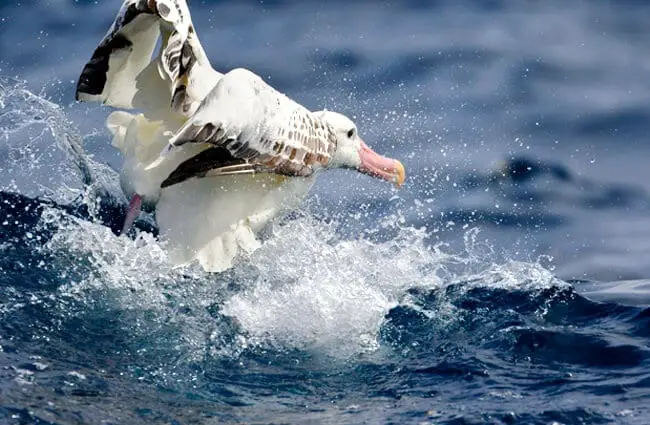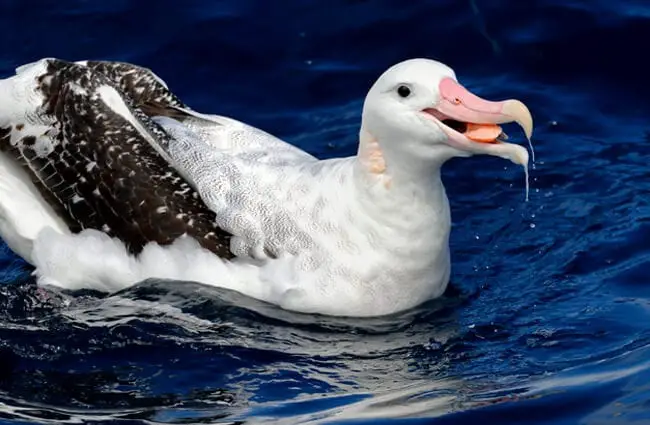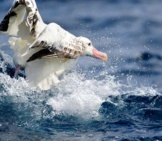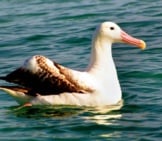The Wandering Albatross is a massive bird known by many names. In various regions, people call this bird a Snowy Albatross, Goonie, and White Winged Albatross.
Not only are they the largest of the 22 albatross species, but they also have the longest wingspan of any bird. Their wings commonly measure up to 10 ft. across, and the largest confirmed specimen had a wingspan over 12 ft. across! Read on to learn about the Wandering Albatross.
Description of the Wandering Albatross
This species of albatross has white plumage, or feathers, with darker wings. Their wing feathers are black, and speckled with varying degrees of white. Young birds have brown feathers, which become white as they age.
This bird’s wingspan is quite large, and averages 10 feet across, though some individuals are larger. Finally, their beaks are moderately long, with a hook at the end to help grasp fish.
Interesting Facts About the Wandering Albatross
This species has the longest wingspan of any living bird … Ever! However, that is not the only notable thing about the Wandering Albatross.
- Monogamous Mates – Once a Wandering Albatross has found a suitable mate, it continues to breed with that bird for the rest of its life. They are doting parents, and take great care in rearing their chicks. It sometimes takes up to 10 months for the chick to learn how to fly and become independent of its parents.
- Time Constraints – Obviously when it takes 10 months to raise a single chick, it can be difficult to jump right back into parenthood. For this reason, Wandering Albatrosses breed once every 2 years.
- Slow to Mature – Adult albatrosses don’t even begin reproducing until they are about 10 years old on average. They sometimes join the other birds at the breeding colonies and perform mating displays. However, most of the time they do not find a mate and begin to breed until they are around 10 years old.
- Slow Growth – Unfortunately, because these birds are so slow to mature, and they breed at a very slow rate, their populations do not increase quickly. Because of this, when their populations decline it takes a long time for them to make a comeback. Humans pose threats to these birds in a number of different ways, and the IUCN lists the species as Vulnerable.
Habitat of the Wandering Albatross
These birds spend the vast majority their life flying over, or floating on the surface of, the ocean. They inhabit the open ocean, primarily where the waters are deep, and fish are plentiful. The only time they come to land is for the mating season. During this time, colonies of birds land on plateaus, valleys, and plains.
Distribution of the Wandering Albatross
There are several different subspecies of Wandering Albatross, all of which live in the open oceans of the Southern Hemisphere. Outside of the breeding season, they roam the open oceans in between Antarctica and the southern coasts of Africa, South America, and Australia. Their primary breeding colonies are on various islands across the Southern Hemisphere, including South Georgia, Macquarie, Amsterdam Island, and more.
Diet of the Wandering Albatross
This seabird unsurprisingly feeds primarily on fish and other aquatic organisms. They eat fish, octopus, squid, shrimp, and krill.
They also scavenge on the remains of carcasses, as well as feeding on the scraps from commercial fishing operations and other predators. Though they can dive if they need to, they catch most of their food at the surface of the water.
Wandering Albatross and Human Interaction
Unfortunately, humans are extremely detrimental to these birds. Sailors have killed birds, both at sea and in nesting colonies, for decades. In fact, humans are the only known predator of adult albatrosses.
Nowadays it is illegal to harm these birds, though killing does still occur. Sadly, they frequently, and accidentally, become trapped in fishing nets or on fishing lines. Humans have also introduced many different feral animals to their breeding islands, and these animals eat the eggs and chicks.
Domestication
Humans have not domesticated this species of bird in any way.
Does the Wandering Albatross Make a Good Pet
No, the Wandering Albatross does not make a good pet. Their huge wings carry them across open ocean, which would make them a poor household pet. It most places, it is illegal to harm, harass, capture, or kill these birds.
Wandering Albatross Care
These birds do not often find themselves in zoos. The only time any albatross species lives in a zoo or aquarium is when something has severely injured them in some way.
During those times, zoos attempt to heal and rehabilitate the birds, and release them back into the wild if possible. Albatrosses that live in zoos because they cannot survive in the wild act as ambassadors to the plight of their species.
Behavior of the Wandering Albatross
This species is quite social, even outside of the breeding season. While in the open ocean, small groups of Wandering Albatrosses forage together. These groups frequently converge upon one another when feeding opportunities, like bait balls or fishing vessels, arise.
As the breeding season arrives, huge colonies of birds flock to their breeding grounds together. Birds searching for mates perform elaborate courtship displays, and mated pairs renew their bonds.
Reproduction of the Wandering Albatross
Every 2 years a pair breeds and produces a single egg, usually in December. Both the male and the female help incubate the egg, which hatches after 2.5 months. Once the chick hatches the parents alternate between keeping it warm and fishing for food.
After the chick is a month old, both parents leave it alone to hunt for food. It takes between 9 and 10 months for the chick to learn how to fly and gain independence.











![Red Angus Closeup of a beautiful Red Angus cowPhoto by: U.S. Department of Agriculture [pubic domain]https://creativecommons.org/licenses/by/2.0/](https://animals.net/wp-content/uploads/2020/03/Red-Angus-4-238x178.jpg)












![Red Angus Closeup of a beautiful Red Angus cowPhoto by: U.S. Department of Agriculture [pubic domain]https://creativecommons.org/licenses/by/2.0/](https://animals.net/wp-content/uploads/2020/03/Red-Angus-4-100x75.jpg)

